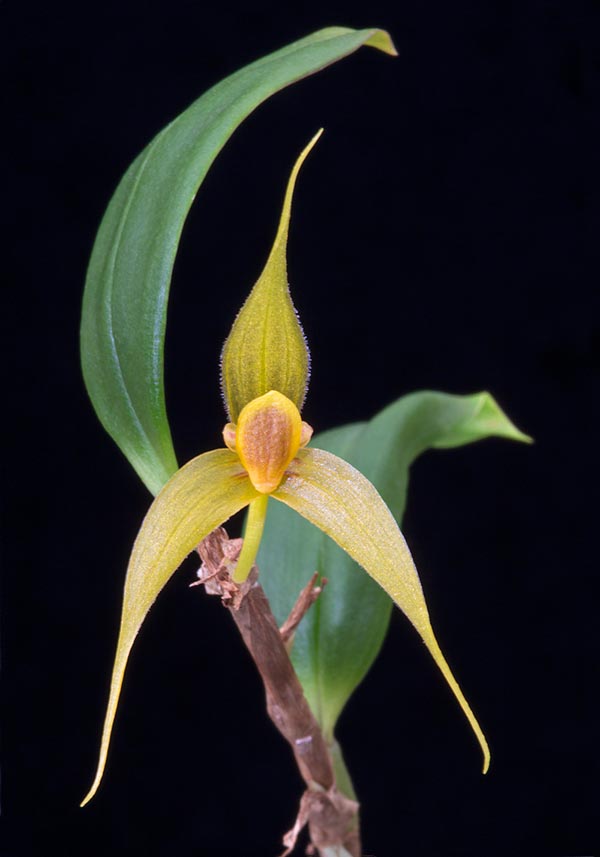Family : Orchidaceae

Text © Pietro Puccio

English translation by Mario Beltramini

Native to Papua New Guinea the Bulbophyllum erythrosema is an epiphyte, rarely cultivated, with a particular way of growth. About 3 cm long inflorescences with only one flower © Giuseppe Mazza
The name of the genus is the combination of the Greek substantives “βολβός” (bolbos) = bulb and “φύλλον” (phyllon) = leaf, with reference to the leaves growing at the apex of the pseudobulbs; the name of the species is the combination of the Greek adjective “ἐρυθρός” (erythrόs) = red and of the substantive “σῆμα” (sema) = mark, spot, with reference to the red spot on the labellum.
The Bulbophyllum erythrosema J.J.Verm. (2008) is an erect or sloping species with a particular mode of growth, the new pseudobulb generates from a subterminal node of the previous one, whose remaining part, with three or more nodes, along with the others preceding it, forms a ramified rhizome, that can reach a length of 50 cm with a diameter of about 0,5 cm, provided of numerous roots especially at the base.
Almost cylindrical pseudobulbs, 1,5-2,8 cm long, spaced of 0,7-1,5 cm, provided at the apex with one only leaf, on a 0,6-0,8 cm long petiole, elliptical with acute apex, 4,5-6 cm long and 1,4-1,8 cm broad, of intense green colour, coriaceous.
The about 3 cm long inflorescences, generates from the nodes along the rhizome and bear only one flower, on an about 1,5 cm long pedicel and ovary, with yellowish sepals with red veins at the base, white yellowish petals with purple central band and red purple labellum with yellow margin. Sepals almost equal, elliptical with caudate apex and margins finely ciliated below, about 2 cm long and 0,5 cm broad, oblong-elliptical petals with acute apex and finely eroded margins, concave, 0,4 cm long and 0,2 cm broad, elliptical-obovate labellum with obtuse apex, concave, 0,7 cm long and 0,4 cm broad, and about 0,2 cm long column.
It reproduces by seed, in vitro, and by division.
Species almost unknown in cultivation, present only in specialized collections, cultivable in the coolest zone of an intermediate greenhouse, well aerated, in partially shaded position, with high and constant atmospheric humidity. It can be placed in pot or baskets with a compost formed by fragments of medium sliced bark, sphagnum and inerts for a best drainage.
The specie is reported in the appendix II of the CITES (species whose trade is ruled at international level).
→ For general notions about ORCHIDACEAE please click here.
